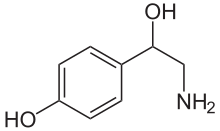Octopamine (drug)
 | |
 | |
| Clinical data | |
|---|---|
| Other names | Norsympathol, Norsynephrine, para-Octopamine, beta-Hydroxytyramine, para-hydroxy-phenyl-ethanolamine |
| Routes of administration | Oral |
| ATC code | |
| Legal status | |
| Legal status |
|
| Pharmacokinetic data | |
| Bioavailability | 99.42 % |
| Metabolism | p-hydroxymandelic acid (if p-octopamine) or m-hydroxymandelic acid (if m-octopamine[1][2] |
| Elimination half-life | 15 minutes in insects. Between 76 and 175 minutes in humans |
| Excretion | Up to 93% of ingested octopamine is eliminated via the urinary route within 24 hours[1] |
| Identifiers | |
| |
| CAS Number | |
| PubChem CID | |
| IUPHAR/BPS | |
| ChemSpider | |
| UNII | |
| ChEBI | |
| ChEMBL | |
| Chemical and physical data | |
| Formula | C8H11NO2 |
| Molar mass | 153.178 g/mol g·mol−1 |
| 3D model (JSmol) | |
| Chirality | Racemic mixture |
| |
| |
| | |
Octopamine (molecular formula C8H11NO2) is an organic chemical closely related to norepinephrine. In many types of invertebrates it functions as an important neurotransmitter and hormone, but in the human body it normally exists only at trace levels and has no known function. Because it shares some of the actions of norepinephrine, octopamine has been sold under trade names such as Epirenor, Norden, and Norfen for use as a sympathomimetic drug, available by prescription. Very little information exists concerning its clinical usefulness or safety.[3]
In mammals, octopamine may mobilize the release of fat from adipocytes (fat cells), which has led to its promotion on the internet as a slimming aid. However, the released fat is likely to be promptly taken up into other cells, and there is no evidence that octopamine facilitates weight loss. Octopamine may also increase blood pressure significantly when combined with other stimulants, as in some weight loss supplements.[4]
References
- ^ a b Hengstmann, J. H.; Konen, W; Konen, C; Eichelbaum, M; Dengler, H. J. (1974). "The physiological disposition of p-octopamine in man". Naunyn-Schmiedeberg's Archives of Pharmacology. 283 (1): 93–106. doi:10.1007/bf00500148. PMID 4277715.
- ^ d’Andrea, Giovanni; Nordera, Gianpietro; Pizzolato, Gilberto; Bolner, Andrea; Colavito, Davide; Flaibani, Raffaella; Leon, Alberta (2010). "Trace amine metabolism in Parkinson's disease: Low circulating levels of octopamine in early disease stages". Neuroscience Letters. 469 (3): 348–51. doi:10.1016/j.neulet.2009.12.025. PMID 20026245.
- ^ Stohs SJ (2015). "Physiological functions and pharmacological and toxicological effects of p-octopamine". Drug Chem Toxicol. 38 (1): 106–12. doi:10.3109/01480545.2014.900069. PMID 24654910.
- ^ Haller, Christine A.; Benowitz, Neal L.; Jacob, Peyton (2005). "Hemodynamic effects of ephedra-free weight-loss supplements in humans". The American Journal of Medicine. 118 (9): 998–1003. doi:10.1016/j.amjmed.2005.02.034. PMID 16164886.
